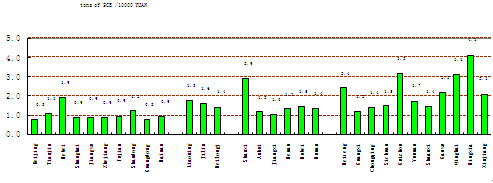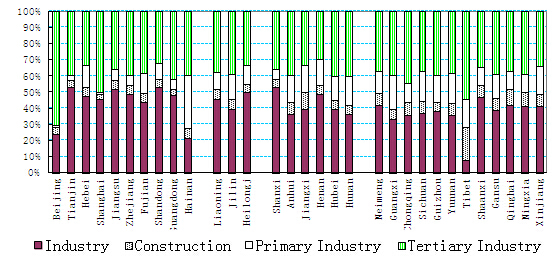Analysis of Factors Causing Different Energy Intensities in China's Different Regions
Oct 26,2009
By Li Shantong, Department of Development Strategy and Regional Economy, and Xu Zhaoyuan, Enterprise Research Institute, the DRC
Research Report No 63, 2009
In promoting economic growth, one of the major targets of China's 11th Five-Year Plan is to constantly increase the efficiency of resource utilization and especially to reduce the energy intensity for per unit of GDP. This is also an important step to ensure that the economy can develop in a sustainable way for a longer time. As there exists a huge unevenness in China's regional development, China should, when boosting the efficiency of resource utilization in all regions, set different energy-saving targets for different regions in light of their unique features so as to reduce both the cost of energy conservation and the unfavorable impact of such a move on the economy. Therefore, China must have an in-depth analysis of the state of the energy intensities in different regions and the impacting factors so as to adopt targeted measures.
I. Great Difference Exists in Regional Energy Intensities
Energy intensity refers to the amount of energy consumed for per unit of gross domestic product (or total output value). It is a quantitative indicator of the national economy to measure the efficiency of energy production and utilization. As different regions have different resource endowments and industrial structures, their energy intensities are also quite different. For example, the national energy consumption intensity in 2006 was 1.206 tce / 10,000-yuan GDP (at the 2005 constant prices). Beijing had the lowest energy intensity of 0.76 tce and Ningxia had the highest intensity of 4.1 tce. The ratio between the highest and lowest values was 5.4 ( Figure 1).

Figure1 Energy Consumption Intensities in Various Regions of China in 2006
Source: China Statistical Yearbook 2007
A horizontal comparison between different regions indicates that energy intensity is affected by three main factors: price level, industrial structure and segmental energy intensity. In terms of price level, the more developed a regional economy is, the higher its price level would be and the lower its energy intensity based on nominal GDP would be. In terms of industrial structure, a region that has a high proportion of high energy-consuming industries also posts high energy consumption for per unit of GDP. In terms of segmental energy intensity, a region with a relatively low technological level and a low efficiency of energy utilization also has relatively high overall energy intensity. II. Great Difference Exists in Regional Industrial Structures
In addition to the total amount of economic development, industrial structure also has an important impact on total energy consumption and energy intensity. The secondary industry and especially the industrial sector consume far more energies than the primary and tertiary industries. Within the industrial sector, different segments also have quite different levels of energy consumption. For example, the energy intensity for per unit of GDP in 2006 at the current prices was respectively 0.34 tce for agriculture, 1.92 tce for industry, 0.31 tce for construction, and 0.41 tce for tertiary industry. The energy intensity of the industrial sector as a whole was clearly higher than that of other segments.
1. Different regions have different structures of primary, secondary and tertiary industries
Figure 2 illustrates the structures of the primary, secondary and tertiary industries in different regions in 2006. It indicates that except a few regions such as Beijing, Shanghai and Tibet, all other regions had a largely identical proportion of the tertiary industry, at about 38%. But they had very different proportions of the primary and secondary industries. The east region, excluding Beijing and Hainan, had a relatively high proportion of industry (at 48.5% on average). It was followed by the northeast region (at 44.4% on average), and the central and west regions excluding Tibet (respectively at 41.5% and 38.7%).
2. Different regions have quite different structures of industrial segments
Among the primary, secondary and tertiary industries, the industrial sector of the secondary industry is the leading energy-consuming sector. Within the industrial sector, different segments consumed very different amounts of energies for per unit of GDP. For example, the economic survey data indicate that in 2004, the energy consumption for 10,000-yuan output value by the segment of non-metal mineral products (building materials, etc) was 1.815 tce, which was 32 times as much as that of the segment of electronics and communications equipment manufacturing (0.056 tce). Therefore, even if two regions have a similar structure of the primary, secondary and tertiary industries, their energy intensities can still be very different if they have different structures of industrial segments.

Figure 2 Industrial Structures of Three Industries in Various Regions of China in 2006 (%)
Source: China Statistical Yearbook 2007
In order to compare the structures of industrial segments among different regions, we divide the industrial segments into three types. Based on each industrial segment's energy consumption coefficient for per unit of gross output value, we define the industrial segments with top one-third energy intensities as the high energy-consuming segments. Likewise, we define those with middle one-third energy intensities as the medium energy-consuming segments, and those with low one-third energy intensities as the low energy-consuming segments1. The high energy-consuming segments mainly referred to some mineral mining, dressing, processing and smelting segments, such as the segment of non-metal mineral products, the segment of metallurgy and coal mining, the segment of oil processing, and the segment of coking and chemicals. The medium energy-consuming segments mainly included the segment of non-metal mineral mining, the segment of oil and natural gas excavation, and the segment of metal mineral mining. The low energy-consuming segments referred to some segments producing capital goods with high technological contents, such as the segment of transport equipment, the segment of electric equipment, the segment of meters and instruments, and the segment of electronics.
Figure 3 and Table 1 illustrate the regional distribution of the industrial segments with different energy intensities in 2006. Overall, the east, northeast, central and west regions claimed a growing proportion of high energy-consuming industrial segments and a declining proportion of low energy-consuming industrial segments. Except Hebei and Hainan, the east region claimed a relatively low proportion of high energy-consuming industrial segments and a relatively high proportion of low energy-consuming industrial segments (respectively at 27.1% and 42.5%). On the other hand, the central and west regions claimed a relatively high proportion of high energy-consuming industrial segments. Not only Shanxi and Inner Mongolia had a relatively high proportion of high energy-consuming industrial segments due to their rich coal resources, but other provinces such as Guizhou, Gansu, Qinghai and Ningxia also claimed a very high proportion of high energy-consuming industrial segments, at about 75%.
…
If you need the full text, please leave a message on the website.
1Based on different segments' energy consumption data in 2006 and the 122-segment input-output table in 2002, we divide the industrial sector in various regions in 2006 into 78 segments.














